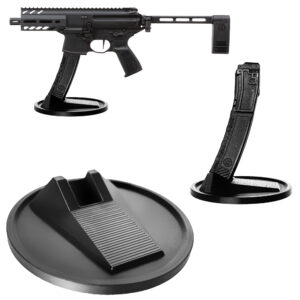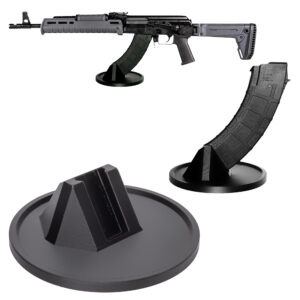
Categories:
The AK-47, developed by Mikhail Kalashnikov in the late 1940s, is renowned for its reliability, simplicity, and effectiveness. A significant aspect of its design is its trigger mechanism, an essential component that determines the weapon’s operational dynamics and ultimately its effectiveness in various combat scenarios. Understanding the AK-47’s trigger mechanism is critical as it plays a pivotal role in the weapon’s function, facilitating the discharge of bullets when activated by the shooter.
The trigger mechanism of the AK-47 is a well-engineered system that enables both semi-automatic and fully automatic firing modes, which are selected through a selector lever. In semi-automatic mode, each pull of the trigger results in the discharge of a single bullet, allowing for controlled, measured shooting. Conversely, in fully automatic mode, holding the trigger down will result in continuous fire until the trigger is released, the ammunition is exhausted, or a malfunction occurs.
At the heart of the trigger mechanism lies the trigger assembly, consisting of the trigger, disconnector, hammer, and sear. When the shooter squeezes the trigger, it acts on the disconnector, which in turn engages the hammer. The hammer is subsequently released to strike the firing pin, igniting the cartridge in the chamber. The explosion from the ignition propels the bullet forward through the barrel and resets the hammer as the spent cartridge is ejected and a new one is chambered.
In semi-automatic mode, the disconnector temporarily captures the hammer after each shot and requires the shooter to release and pull the trigger again for subsequent shots. This precise interaction between the trigger, disconnector, and hammer ensures consistent, single-shot firing. In fully automatic mode, the disconnector bypasses this reset, allowing the hammer to continuously engage the firing pin as long as the trigger remains depressed.
The AK-47’s trigger mechanism embodies a balance between simplicity and robustness, making it easy to maintain even in adverse conditions. This design philosophy contributes to the AK-47’s legendary reliability and ease of use, which has led to its widespread adoption and enduring presence on battlefields worldwide.
The mechanism by which an AK-47 is fired is intricate, involving multiple components that work in unison to ensure reliable operation. At the heart of this process is the trigger assembly, consisting of several key elements, each playing a crucial role. From the moment the shooter pulls the trigger, a series of mechanical interactions occur, all designed to facilitate the firing sequence.
The trigger itself is a fundamental component, acting as the interface between the shooter and the weapon. Upon pulling the trigger, it pivots on a pin, transferring energy to the trigger sear. The sear is a critical element, responsible for holding the hammer in a cocked position until the shooter decides to fire. When the trigger is engaged, the sear releases the hammer, initiating the next phase of the firing cycle.
The hammer, typically under tension from a compressed spring, is released by the disengaging sear. It swiftly moves forward to strike the firing pin, which in turn, ignites the primer at the base of the cartridge in the chamber. This action propels the bullet forward, while the expanding gases produced from the ignited powder drive the bolt carrier rearward. An essential part of the trigger assembly is the disconnector.
This component ensures semiautomatic operation by capturing the hammer after each shot, preventing it from falling while the shooter maintains pressure on the trigger. The disconnector holds onto the hammer until the trigger is released, at which point the sear re-engages, readying the hammer for the next shot. Additionally, the safety lever is designed to prevent accidental discharge. When placed in the “safe” position, this lever physically blocks the trigger from moving, and in some designs, it also locks the bolt carrier, adding a layer of security.
Finally, the trigger spring ensures the trigger returns to its initial position after being pulled. This spring, often a coil type, applies constant pressure to the trigger mechanism, resetting it swiftly and consistently, allowing for subsequent shots when the trigger is released and engaged again.
When a shooter aims to fire an AK-47, they engage in a series of intentional actions to activate the weapon’s trigger mechanism, resulting in the discharge of a bullet. The process begins with the shooter assuming a proper stance and grip, ensuring that the rifle is securely held with the buttstock pressed firmly against the shoulder. This positioning is critical for managing the recoil and maintaining control of the gun.
With the AK-47 properly aimed, the shooter’s finger moves to rest on the trigger within the trigger guard. Upon deciding to fire, the shooter applies steady pressure to the trigger. This pressure is transmitted through the trigger lever, which pivots on a pin and causes the disconnector to disengage from the rear of the trigger. As this happens, the disconnector releases the hammer, which has been under tension from the compressed hammer spring.
When the hammer is freed, it is propelled forward by the hammer spring with considerable force. The forward motion of the hammer brings it into contact with the firing pin located in the bolt carrier group. The firing pin is driven sharply forward by the impact of the hammer, striking the primer of the cartridge seated in the chamber.
The primer ignites a small explosive charge, which in turn ignites the larger propellant charge inside the cartridge. The rapid combustion of the propellant generates high-pressure gas, propelling the bullet down the barrel and out of the muzzle with great velocity. Simultaneously, the gas expansion pushes the bolt carrier rearward, initiating the cycle of extracting the spent cartridge and chambering a new round.
Thus, by a delicate yet deliberate application of finger pressure on the trigger, the shooter initiates a complex sequence of mechanical events culminating in the firing of a round. Each component within the AK-47’s trigger mechanism plays a vital role in ensuring that this process is both rapid and reliable, allowing the weapon to perform effectively in various conditions.
The hammer plays a crucial role in the function of an AK-47’s trigger mechanism, acting as a key component that facilitates the firing sequence. When the shooter applies pressure to the trigger, a series of mechanical events is set into motion, culminating in the hammer’s pivotal role. Upon pulling the trigger, the sear holds back the hammer under the tension of a coiled spring.
The trigger releases the sear, allowing the spring to propel the hammer forward with substantial force. The motion of the hammer is directed towards the firing pin, a slender metal rod positioned to ignite the primer of the cartridge seated in the chamber. The trajectory of the hammer is meticulously calibrated to ensure it strikes the firing pin with enough energy to cause ignition but not so much as to damage the mechanism.
As the hammer strikes the firing pin, the resultant force pushes the firing pin forward, causing it to impinge upon the primer of the cartridge. The primer, a sensitive chemical compound, ignites under the impact, generating a small but intense burst of flame. This flame permeates through the flash hole into the cartridge case, igniting the main propellant charge. The rapid combustion of this charge creates an expanding gas that propels the bullet forward through the barrel and towards its target.
In semi-automatic operation, the AK-47’s gas-operated system utilizes a portion of the propellant gas to cycle the bolt carrier group, resetting the hammer in the process. As the bolt carrier group travels rearward, the hammer is recocked, compressing its spring once more and engaging the sear. When the bolt carrier returns to its forward position, another round is chambered, and the weapon is ready to fire again upon the next trigger pull.
In automatic mode, the hammer’s operation is slightly modified by an auto sear, which ensures continuous firing as long as the trigger remains depressed. The auto sear momentarily catches the hammer during each cycle and releases it once the bolt carrier returns to the forward position, enabling rapid successive shots. The hammer’s role is integral, serving as the critical intermediary that converts the mechanical action of the trigger pull into the chemical reaction necessary to launch a projectile.
The interaction between the trigger and the sear is a fundamental aspect of the AK-47’s firing mechanism. When the shooter applies pressure to the trigger, a chain of mechanical events is set into motion, ultimately allowing the rifle to discharge a round. The trigger is connected to the sear, which is a crucial component responsible for controlling the hammer. Initially, the hammer is held back in a cocked position by the sear, which acts as a locking mechanism.
This ensures that the hammer cannot move forward to strike the firing pin and ignite the cartridge in the chamber until the trigger is deliberately pulled. The sear is engaged with the hammer via a notch, creating a secure hold. As the shooter pulls the trigger, the trigger bar pushes on the sear, causing it to pivot out of its engagement with the hammer.
This action releases the hammer from its locked, cocked position. The hammer is under tension from a coiled spring, and once released, it is propelled forward with significant force. This forward motion of the hammer is a critical step, as it transfers energy to the firing pin, driving it into the primer of the cartridge to create an ignition spark. The precision with which the trigger disengages the sear is vital for the reliability and safety of the gun.
The interaction must be smooth and consistent to ensure that the hammer is released only when the shooter intends. Any irregularities or malfunctions in this interplay could result in misfires or accidental discharge, posing serious risks. In semi-automatic mode, this cycle of engagement and release happens with each individual pull of the trigger. After the hammer strikes the firing pin, it is pushed back into the cocked position by the action of the recoil system, re-engaging the sear and preparing the weapon for the next shot.
In automatic mode, the sear and an additional component called the auto-sear work together to allow the hammer to be automatically released with each cycling of the bolt, as long as the trigger is held down.
The AK-47, renowned for its reliability and simplicity, incorporates several safety mechanisms in its trigger system designed to prevent accidental discharges and ensure controlled firing. Central to these safety features is the selector lever, a robust component that regulates the mode of operation and effectively locks the trigger mechanism when engaged in the “safe” position. When the selector lever is positioned in the uppermost or “safe” mode, it blocks the trigger bar from moving rearward and engaging the sear, immobilizing the firing system and preventing the hammer from being released to strike the firing pin.
Additionally, the design of the AK-47 trigger mechanism incorporates a disconnector, which plays a pivotal role in maintaining the gun’s safety by ensuring that the hammer only strikes the firing pin when the trigger is deliberately pulled. After each shot, the disconnector engages the hammer, holding it in a cocked position until the trigger is released and reset. This mechanism acts as a fail-safe to prevent multiple rounds from discharging with a single trigger pull, which is crucial in maintaining the select-fire capabilities of the weapon.
Another significant safety element is the robustness of the hammer and sear engagement surfaces. These components are designed to withstand extensive wear and tear without compromising their functionality, ensuring that the hammer remains securely engaged with the sear until the shooter applies deliberate pressure on the trigger. This reliability is essential in preventing accidental discharges due to mechanical failures or external impacts.
Furthermore, many AK-47 models are equipped with a bolt safety feature that prevents the bolt from engaging fully if the hammer is not correctly cocked. This measure ensures that the rifle cannot chamber a round and go into battery unless the hammer and trigger mechanism are properly aligned, adding another layer of security against accidental firing.
These intrinsic safety mechanisms embedded within the AK-47’s trigger system underscore the weapon’s design philosophy, striving to balance operational reliability with user safety. By incorporating redundancies and robust components, the AK-47’s trigger safety measures significantly reduce the risk of unintentional discharges, thereby enhancing overall gun safety for users in various operational environments.
The maintenance and troubleshooting of the AK-47 trigger mechanism are crucial aspects of ensuring the reliable performance and longevity of this legendary gun. Understanding the intricacies of the trigger mechanism, performing regular maintenance, and accurately diagnosing any malfunctions are essential for any owner or operator. At the heart of the AK-47 trigger mechanism lies a simple, yet robust, design that includes components such as the trigger, hammer, disconnector, and springs.
Regular maintenance begins with thorough cleaning, as carbon buildup and debris can hinder the smooth operation of the trigger. Dismantling the trigger assembly for cleaning requires basic tools and a careful approach to avoid damaging any parts. It’s important to use appropriate solvents and lubricants designed for guns to clean residue from the trigger, hammer, and other small parts. After cleaning, ensure that each component is dry and apply a thin layer of lubrication to reduce friction and wear.
Regular inspection of the trigger mechanism is essential for identifying potential issues before they become serious problems. Check for signs of wear on the surfaces of the hammer, trigger, and disconnector. Any significant wear or deformation may indicate the need for replacement parts. Pay attention to the condition of the springs, as weakened or broken springs can lead to trigger malfunctions or failure to fire.
Ensuring that all pins and retaining springs are in their correct positions and secure is also crucial. Troubleshooting issues with the AK-47 trigger mechanism involves a systematic approach to identify the root cause. Common problems include trigger slap, failure to reset, double firing, and failure to fire. Trigger slap, where the trigger strikes the shooter’s finger forcefully, can often be addressed by inspecting the fit and finish of the disconnector and hammer.
Adjusting or replacing these components might resolve the issue. Failure to reset usually indicates a problem with the disconnector spring or the sear surface’s engagement, requiring careful adjustment or part replacement. Double firing incidents might be the result of worn or damaged parts, necessitating a detailed inspection and possibly the installation of new components. Understanding these maintenance and troubleshooting procedures ensures the AK-47 trigger mechanism operates smoothly and reliably, minimizing downtime and enhancing the user’s shooting experience.








Colt
Colt M4 Carbine
Colt LE6920
Colt AR-15 A4
Daniel Defense
DDM4 V7
DDM4 V9
DDM4 V11
DDM4 ISR (Integrally Suppressed Rifle)
Smith & Wesson (S&W)
M&P15 Sport II
M&P15 Tactical
M&P15T
Bravo Company Manufacturing (BCM)
BCM Recce-16
BCM Recce-14
BCM MCMR Series
Aero Precision
M4E1 Series
AC-15
AR15 Pistol (Various Configurations)
Ruger
Ruger AR-556
Ruger SR-556
Ruger AR-556 MPR (Multi-Purpose Rifle)
Springfield Armory
Saint Victor
Saint Edge
Saint AR-15
PSA (Palmetto State Armory)
PSA PA-15
PSA AR-V
PSA Jakl (AR Pistol)
FN America
FN 15 Tactical Carbine
FN 15 Patrol
FN 15 DMR
Wilson Combat
Recon Tactical
Super Sniper
Protector Carbine
SIG Sauer
SIG M400 Tread
SIG M400 Elite
SIG M400 SDI
LWRC International
IC DI (Direct Impingement)
IC SPR
IC A5
Bushmaster Guns
XM-15 QRC
Bushmaster MOE
XM-15 Patrolman
Rock River Arms
LAR-15 Entry Tactical
LAR-15 Predator
LAR-15 Elite Comp
Stag Arms
Stag 15 Tactical
Stag 15L (Left-Handed Models)
Stag 15 Valkyrie
Noveske Rifleworks
Noveske Gen 4 N4
Noveske Space Invader (AR Pistol)
Noveske Recon
Anderson Manufacturing
AM-15 Optic Ready
AM-15 M4 Carbine
AM-15 Precision Rifle
Adams Arms
AA-15 Piston Rifle
P2 AARS (Adams Arms Rifle Series)
Black Rain Ordnance
SPEC15 Series
BRO Predator
Fallout 15
Diamondback Guns
DB15 Series
DB15CCMLB
DB15EB
Del-Ton Inc.
DTI-15
Del-Ton Echo 316H
Sierra 316M
Windham Weaponry
Windham SRC
Windham VEX-SS
Windham RMCS-4 (Caliber Conversion System)
Christensen Arms
CA-15 G2
CA-15 Recon
CA-15 Titanium Edition
Patriot Ordnance Factory (POF-USA)
Renegade Plus
P415 Edge
Revolution DI
LaRue Tactical
PredatAR
OBR (Optimized Battle Rifle)
LaRue Stealth 2.0
Battle Arms Development
Workhorse Patrol Carbine
BAD556-LW (Lightweight)
Authority Elite Rifle
Faxon Guns
Ascent AR-15
FX-19 (AR Pistol)
Streamline Ultralight Series
KE Arms
KE-15 SLT (Super Lightweight Tactical)
KE-15 Scout Carbine
Primary Weapons Systems (PWS)
MK1 MOD 2-M
MK116 PRO
MK107 (Piston AR Pistol)
ZEV Technologies
ZEV Core Elite Rifle
ZEV AR15 Billet Rifles
Franklin Armory
BFSIII AR-C1
Militia Model
F17-L (Chambered in .17 WSM)
Seekins Precision
SP15 DMR
NX15 Skeletonized Rifle
Havak Bravo
Aero Precision (Additional Models)
EPC-9 (Pistol Caliber ARs)
VG6 AR Rifles
Barrett Guns
REC7 DI
REC7 Gen II
CMMG
MK4 RCE
Resolute 300
Banshee (AR Pistol)
DPMS Panther Arms
Panther Oracle
Panther LR-308
H&K (Heckler & Koch)
HK MR556A1
HK416 (Military Variant)
Rock Island Armory (Armscor)
VR-80 Tactical AR (Shotgun AR Platform)
Troy Industries
Troy SPC-A3
Troy PAR (Pump Action AR)
Wilson Tactical
Tactical Recon AR
Protector Series
F1 Guns
FDR-15 Skeletonized Rifle
BDRx-15 Series
Juggernaut Tactical
JT-15
JT-10 Precision Rifle
AeroSurplus
Surplus AR-15 Rifles (Budget Models)
Thunder Tactical
AR-15 Basic Carbine
Tactical Builder Sets
Radical Guns
RF-15
Forged AR-Series
Dark Storm Industries
DS-15 Featureless Rifles
DS-10 Typhoon
DRD Tactical
Paratus
Aptus AR Rifles
Bear Creek Arsenal
BCA-15
AR Complete Upper Builds
Aero Survival Rifles (ASI)
ASR Tactical Series
Tactical Edge
WARFIGHTER Series
AR-15 Lightweight Rifles
Lone Star Armory
TX15 DMR
TX15 Carbine
HERA Arms
HERA H7
HERA AR-15 Lower Builds
IWI (Israeli Weapon Industries)
Zion-15
DRD Tactical
Tactical Modular Rifles
Quick-Takedown Rifles
V Seven Weapons
1776 Rifle
Hyperlite Rifle
Core Rifle Systems
Core15 Tac III
Core15 Patrol Rifle
Armalite (Original AR-15 Creator)
M15 Tactical
M15 A4 Carbine
DEF15 (Defensive Sporting Rifle Series)
PSA (Palmetto State Armory Additional Models)
PSAK-47 Hybrid (AR-AK Style Hybrid)
PSA Dagger (Pistol Caliber Configurations)
Odin Works
OTR-15
Odin Recon Rifle
Maxim Defense
MDX-508 PDX (Compact AR Pistol)
MDX-510 Rifle